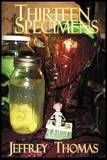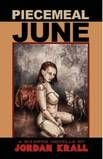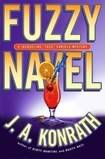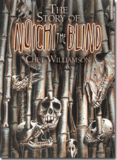Thirteen Specimens / Jeffrey Thomas
 Delirium Books / July 2008
Delirium Books / July 2008
Reviewed by: JG Faherty
Jeffrey Thomas is one of those writers who was new to me when I picked up his collection of short stories. Right away, the title caught my attention: Thirteen Specimens. A cool title. One that had me anticipating stories of the strange, oddities and freaks perhaps. Or, as the back cover says, ‘...a collection of bizarre and disturbing short stories, poems, and odd bits and pieces found preserved in dusty jars of formaldehyde in a sealed-off room in the condemned museum of the mind of author Jeffrey Thomas.’
Well, in reading this book, I got more strangeness than I bargained for.
Thirteen Specimens includes short stories, novellas, and poems. Thomas handles all of these forms well, although he is strongest, I feel, with the short stories, and weakest with the poetry. He writes with a fluid, natural style that is at once literate but not pretentious; complex but still easy to read.
Unfortunately, the stories themselves didn’t, for me, compare to Thomas’s talents as a writer.
The tales in Thirteen Specimens all fall into a broad category of sci-fi/horror; demons and monsters strut happily alongside aliens, Hindu goddesses, murderers, and alternate realities. This isn’t a problem - God knows people have argued for years about whether films like Alien or Pitch Black are horror or sci-fi, when the truth is they’re both. It’s actually a nice departure from the regular, horror-at-home stories we usually see.
No, the problems I found were of two kinds: sometimes the weirdness grew so weird that the story no longer made sense, and sometimes the endings just weren’t there, as if the entire purpose of the story was just to create something weird.
Reading this book was like taking a hit of low-grade acid; everything felt off-kilter, out of step. And it may be that a lot of readers will enjoy this feeling, but I’m not one of them.
Let’s take a look at some of the stories.
The first story in the book, “These Are The Exhibits,” gets off to a great start. A woman is visiting a museum filled with weird animals that don’t exist in our world, but do in Thomas’s alternate Earth. Giant bugs, cannibal oysters, mythical gazelles. While there, she gets a private tour from a museum guide, who tells here the sordid stories behind each exhibit, all of which have to do with the man who supposedly founded the museum and his dead wife. It’s only after the tour is over that she finds out from someone else that the guide had inserted himself and his own into stories taking place hundreds of years in the past, and that the museum owner’s wife never existed. And, that the museum has no guides.
What was Thomas going for here? I don’t know, but after reading this story, I found myself saying, “Huh? That’s it? What’s the point?” 14 pages of great story ruined in 1 paragraph.
And it doesn’t stop there.
In “American Cchinnamasta,” we tag along as a young Indian (from India, not Native American) woman dwells on her sad family situation - a father who impregnated a white woman, and then abandoned the family because he wanted an Indian woman and child instead. The narrator goes on about how she compares herself to her sister, and wishes she was full Indian. She also drones on about Hindu gods and goddesses. In the end, however, all the build-up leads us to a rather pedestrian ending, and the entire story turns out to be nothing more than a case of murder.
“October 32nd“is perhaps the oddest and most maddening story in the collection. A man is driving along on Halloween night, in a car that is alternately running on empty and filled with gas. He sees strange things in the mist - mysterious figures, something that might be a werewolf, a crossing guard who is still sitting in the middle of the road at night. In the end, the narrator fills up again, pays the man/monster at the pump, and then can’t decide whether to go home and watch a horror movie or drive around and enjoy the magic of Halloween some more.
Again, I had to say, ‘Huh?’ Once more I was left hanging, dangling in the mist of the story’s ambiguousness.
Now, I don’t want to give the impression that all the stories were bad. In fact, I enjoyed two of them (“Close Enough” and “Monster”) quite a bit. “Close Enough” takes us to an alternate Viet Nam in flashback, and it’s a deeply thoughtful, emotional story, which I can’t go into more detail about because it would give away the ending (it really has one!). And “Monster” is simply a good, straight sci-fi story involving plastic surgeons at an off-world, multi-species colony who find that treating alien patients can sometimes be quite dangerous.
According to the back of the book, several of the stories (including “Monster”) take place in alternate realities that Thomas has written about before, so fans of his should be happy about this.
All in all, this collection didn’t do it for me, but judging from Thomas’s past record (he’s been nominated for Stoker Award and been featured in Year’s Best Fantasy and Horror, his writing has plenty of fans. Perhaps it’s me. Maybe I just don’t get it. I’ve looked him up on the web, and his previous story collections and novels have gotten great reviews. Thomas’s writing is strong enough for me to definitely give him another chance. Maybe his other stories are more in line with what I prefer - concrete endings, as opposed to tales that just fade away or stop somewhere unexpectedly.
But if you like tales of the strange, stories that take left turns to nowhere, and alternate universes where anything is possible, then this book might just be for you.
So, my final verdict is that while it wasn’t my cup of tea, I’d recommend giving Thirteen Specimens a try, because everyone’s tastes are different.
Purchase Thirteen Specimens by Jeffrey Thomas.
Piecemeal June / Jordan Krall
 Eraserhead Press / January 2008
Eraserhead Press / January 2008
Reviewed by: Jeff Burk
Kevin is your average loser, living above a porn-shop with his tarot card-reading cat. In addition to divination, his cat has been bringing home latex body parts, which Kevin soon fashions into a piecemeal sex doll. Once Kevin has all the pieces glued together, the doll comes to life. Her name is June, and she is on the run from an evil pornographer.
Piecemeal June is the first novella from Jordan Krall, and Eraserhead Press has managed to snag this interesting new talent. The book is filled with grotesque imagery of perverted sexuality, yet this is no mere exercise in exploitation. Kevin is seeking real love and companionship from June, and Krall’s use of a sex-doll as a representation of his emotional longing is a wonderfully clever plot device.
Krall’s writing flows nicely, whether he is detailing the sex doll coming to life or crab-human hybrid assassins. The surrealism and weirdness never overwhelm the sweet sensitivity of Kevin's inner plight. This story is for the romantic in all of us, while not neglecting the part that craves gore.
Krall is an exciting new voice to arrive on the horror scene. He combines gross-out with occultism but never forgets that characters are what make a story.
Eraserhead press has consistently published cutting-edge genre works and Piecemeal June continues in this trend of excellence. If your appetite for horror lately needs satisfying, Piecemeal June is a tasty small morsel (just under 100 pages) that very well may be just what you’ve been craving.
Purchase Piecemeal June by Jordan Krall.
Coffin County / Gary Braunbeck
 Leisure / May 2008
Leisure / May 2008
Reviewed by: Blu Gilliand
Cedar Hill, Ohio, is a tough place to live. It’s a blue-collar town where most people make a living doing back-breaking work, turning shifts in factories, standing on their feet all day, collecting meager wages and holding out hope that one day things will get just a little bit better. It’s a town full of the kind of honest, hardworking people who are the heart and backbone of the country.
But simmering underneath all of that apple pie and red-white-and-blue are dark and sinister forces, things that have bubbled up from the ground many times before in Cedar Hill’s history, and which are now reaching a boiling point.
Coffin County, Gary Braunbeck’s latest in a long line of Cedar Hill stories and novels, is that boiling point. In a compact 270 pages, Braunbeck weaves together many of the various events and characters his readers have met in previous Cedar Hill stories (the majority of which are gathered in two collections from Earthling Publications, Graveyard People and Home Before Dark, with a third – The Carnival Within – on the way) and novels (including In Silent Graves, Keepers, and Mr. Hands). However, readers new to Cedar Hill work shouldn’t avoid this book – the author skillfully brings everyone up to speed without slowing the action down. You’ll get all you need to know to enjoy this as a standalone novel, but make no mistake – it’s a richer reading experience if you’ve visited Cedar Hill already.
Coffin County is storytelling on a cosmic scale, but Braunbeck keeps events grounded in cold, hard reality. It starts off quickly with the destruction of a large chunk of the town, then shifts focus to the investigation of a massacre at a local diner. Here the story bogs down a bit, as forward momentum is nearly lost in detailing the intricacies of fingerprint identification technology. It’s interesting information, and it leads to more than one jaw-dropping revelation as to the nature of the events going down in Cedar Hill, but it seems like it could have been shortened a bit.
Fortunately, it’s not long before the pace picks up again. Events begin to spiral out of control, but it is chaos with a purpose. It soon becomes clear the perpetrator is really trying to get the attention of one man, a Cedar Hill resident who already has more to deal with than he can handle. The two do meet near the end of the book – but as readers will see, it’s more a beginning than an end.
There’s a lot going on in what appears on the surface to be the story of a killer hell-bent on destroying an entire town. It’s important to remember going in that Braunbeck isn’t just telling a story in the pages of this novel – he’s been telling one big story all along.
And what a story it is.
Purchase Coffin County by Gary Braunbeck.
Fuzzy Navel / J.A. Konrath
 Hyperion / July 2008
Hyperion / July 2008
Reviewed by: Martel Sardina
J.A. Konrath is the P.T. Barnum of the mystery world. Like Barnum, he is a businessman. Konrath has documented the journey from zero to hero on his blog called The Newbie’s Guide to Publishing. But more importantly, like Barnum, Konrath is out to entertain.
In Fuzzy Navel, the fifth book in the Jacqueline “Jack” Daniels series, Konrath walks the fine line of blending just the right amount of back story to remind readers where they’ve been without being boring and bring new readers into the fold. Lieutenant Daniels is one of the Chicago Police Department’s finest officers. She’s solved some tough cases earning the respect of her male peers. While she’s good at her job, her love life is generally a train wreck. She’s fought hard to keep her relationship with Latham Conger together, and the two are now engaged. Things seem to be looking up for Jack. She’s just received word that Alex Kork, one of the most dangerous serial killers she’s ever faced, committed suicide in prison. Maybe now, her chronic case of insomnia will finally go away.
The calm before the storm isn’t a new concept but it is an important part of the story. Seeing the life Jack had and knowing what she’s gone through to get this far causes the reader to hope maybe, just maybe, she’ll finally get a little peace. Half of the fun of following a series is living with the character through those highs and lows. Fuzzy Navel offers plenty of both.
Jack has her work cut out for her this time around. A group of overzealous vigilantes forget who the bad guys are in their quest to rid the city of scum, leaving dead cops in their wake. Jack becomes a target when the group’s leader thinks she could identify him. This is the least of Jack’s worries. After receiving a strange phone call from her elderly mother, Jack ducks out on a de-briefing meeting with Internal Affairs, a move that could send her back to the civilian world for good. Especially if the higher-ups find out that she moved outside the city limits, which is a violation of CPD policy. Worse yet, comes the realization that the relief gained in learning of Kork’s suicide may be short-lived.
Konrath takes readers on roller coaster ride that soars higher on fear scale than any of the preceding books in the series. He also plunges Jack to an emotional low, leaving us to wonder if Jack will be able to find the strength to fight another day. Like its predecessors, Fuzzy Navel offers a unique blend of humor, gore, mystery, and thrills. Think Janet Evanovich crossed with Thomas Harris, and then turn it up to eleven. The result is a book you’ll find hard to put down.
Purchase Fuzzy Navel by J.A. Konrath.
Dark Tales: Volume 12 / Edited by Sean Jeffery
 Dark Tales / May 2008
Dark Tales / May 2008
Reviewed by: Vince A. Liaguno
Angels, creepy crawlies, ruminations on death, and the Australian Outback are just a few of themes explored in this twelfth volume of short stories from British publisher Dark Tales. Clocking in at a lean 69 pages, Dark Tales: Volume 12 offers up a smorgasbord of thirteen original works of short fiction with a decidedly British flair.
The collection kicks off with Gary Kemble’s eco-terror thriller “All You Need Is Love,” in which a probe returning from Venus brings back a virus that has those it infects inexplicably grinning from ear to ear and doing some decidedly reckless things. “All You Need Is Love” is a cautionary tale that explores the tenuousness of international relations in a time of global paranoia.
“The Summer Ghost” by Robert Smith is a competent war-time ghost story that underwhelms at first but ultimately delivers the goods in the end with some ingenious spectral role reversal.
Ryan Lambie’s “The Beetles in My House” finds its entomology-loving narrator playing house with thousands of creepy crawlies. Think of the “They’re Creeping Up on You” vignette from Creepshow – substituting beetles for cockroaches – and imagine E.G. Marshall’s character welcoming the insect invasion.
“The Billabong” by Angela Graham is a somewhat disjointed take on marital infidelity in the Australian Outback. Despite its strong sense of setting, the story comes across as muddled as the snake-bitten main character’s increasingly hallucinogenic thoughts. The tale ultimately succeeds at macabre, but one is left with the impression that it’s almost by default.
John Morgan’s “Lights Out” is a clever variation on the idea of hovering between life and death, offering up a genuinely disturbing alternative to white-lit corridors with its grisly otherworldly hospital where the Hippocratic Oath is turned on its head before losing its head altogether. Morgan capably demonstrates that sometimes experimental works.
“Trail of Tears” by T.R. Johnstone is a grim apocalyptic survival story with just a hint of zombie lore that fully engages the reader from the opening paragraph. Think Mad Max Beyond Thunderdome meets The Children of Men.
Christopher M. Geeson’s “Love Thy Spider” is a genuinely creepy little tale about an elderly widow and her unwelcome arachnid houseguest who just won’t seem to leave. Talking spiders can be tricky business, but Geeson pulls it off admirably without veering off into parody territory.
In the fable-like “Angels and Oblivion, author Ben Langley offers an inventive spin on guardian angels that explores the depths of divine intervention – imagined here as a corruptible force. It’s an optimistic story about recovery and redemption, perhaps a bit of misplaced hope here among a collection of dark tales but thoroughly enjoyable nonetheless.
“Pulling Teeth” by James Brooks concerns a traveling cookery salesman who takes his Williams & Sonoma-like sideshow to the secluded home of an eccentric old woman who has a thing for wild boars and eagle owls. The story, while passable, is the weakest of the lot with some clunky turns of phrase and an odd aversion to commas in setting off introductory phrases that could have benefited from a more thorough line edit. Mechanics aside, there’s an appropriately ghoulish ending that’ll have you glancing sideways at your grandmother’s tube of Fixodent.
The standout of the collection is David Turnbill’s elegiac “The Dream of Aquiline Wings,” the story of a teenage girl literally at war with herself to stop the nightmarish avian transformation taking place within her. Turnbill crafts a beautifully written allegory for adolescence and the ravaging effects of divorce on children.
Sandi Sholl-Ellis’ “A Brush with Death” is a solid, at times poignant, chiller in which a dying woman - who knows death well after a lifetime of obsession - makes a deal with the Grim Reaper. Sholl-Ellis’ keen observations on aging and death are spot-on, as illustrated by this passage in which the narrator is observing the nursing home setting around her:
Now, at eighty-seven, I have heard all the dogmas of death. In the nursing home, they say it can be your friend. I can rid you of pain. It can take you to where there is no smell of yesterday’s shit and piss blended with today’s powdery adult diapers and disinfectant cleansers.
In death you won’t hear the outbursts of madness and confusion that are answered in barely disguised frustration and disgust in the middle hours of the night.
“Lady! Hey lady! Help me.”
“You need to lie down now.”
“Help! Help me. Can you help me? Lady!”
“Just take a sip of this. Swallow it down. There’s a good man now.”
There will be no clang and clamour of aluminum carts rolling on hard, cold institutional floors in death. No murmurings of rubber soled shoes on gurneys.
That’s what people say. Other people
Grief and madness are the central themes of “Famine,” in which author Chris Warmer takes readers from 0 to 60 mph in what starts out as a poignant and thoughtful portrait of a recently widowed man and abruptly switches to an outlandish conclusion in which an elevator and an underwear model figure into attempted cannibalism. Best to hold onto the chair arms when reading this one.
All is not what it seems in David Hamilton’s ambitious “Baltic Afternoon” in which a young girl becomes a pawn in a game of induced memories and paranormal hoaxes in a Nazi-occupied Baltic village outpost in 1944. You may find yourself re-reading the last paragraphs as Hamilton attempts a denouement twist reminiscent of M. Night Shyamalan’s The Village.
While the compact and concise scares offered in Dark Tales: Volume 12 are perfect to squeeze in during an afternoon at the beach this summer, these tales are best served up late afternoon with a steeping brew of Earl Grey and a nibble or two of orange scone.
Purchase Dark Tales: Volume 12, edited by Sean Jeffery.
The Story of Noichi the Blind / Chet Williamson
 Cemetery Dance / November 2007
Cemetery Dance / November 2007
Reviewed by: Martel Sardina
In the introduction to The Story of Noichi the Blind, Chet Williamson leads readers to believe that the work they are about to read could be a lost manuscript of Lafcadio Hearn (a/k/a Koizumi Yakumo,) a late nineteenth century author, who is best known for his collections of Japan legends and ghost stories. Determining whether it is or isn't is half the fun in this literary game of fact or fiction.
The tale of how Williamson came to be in possession of said manuscript is believable. Williamson discusses the process he went through to verify the authenticity of the manuscript. While he can’t provide a definitive answer, Williamson promises that the Afterword penned by one Dr. Alan Drew, Ph.D. will “shine more light on the question of authorship for the curious reader.” Perhaps. Perhaps not.
Noichi, a woodcutter, lives a meager existence. He befriends forest animals, great and small. One day, he discovers an injured woman the road. Noichi recognizes Noriko, a woman who works for one of his customers. In town, Noichi heard that Noriko murdered a Samurai captain and knows she is in great danger. When he learns the truth of what happened to Noriko, Noichi takes her in, promising to protect her from the Samurai. They eventually marry and live a happy, simple life in the hills above town.
Noriko falls ill and when Noichi’s herbal remedies fail to cure her, he is forced to seek the aid of a doctor. He knows bringing a doctor in is a risk, since Noriko is a fugitive. Noichi cannot bear the thought of losing Noriko. It is a risk he has to take.
Until this point, the tale is a beautifully rendered love story. There is some graphic violence related to Noriko’s encounter with the Samurai captain. But the reader is able to overcome the shock because of the compassion Noichi shows Noriko afterward. As their relationship progresses, it is easy to get caught up in the love story, thus making what is to come more tragic.
The aftermath of the doctor’s visit reminds this reviewer of her introduction to Japanese horror, which started with Takashi Miike’s film, Visitor Q. Sensitive readers who find graphic violence and taboo subjects, such as necrophilia, offensive are hereby warned to steer clear of this novella and Miike’s films as well. But those who enjoy black comedy and other perversions will delight in what the rest of The Story of Noichi the Blind has to offer.
Dr. Alan Drew, Ph.D., does offer insight into the similarities between The Story of Noichi the Blind and Hearn’s other tales. Is Williamson’s find an authentic lost Hearn treasure? Are Williamson and Drew really qualified to make that determination? Is Drew just a fictional pawn in Williamson's literary game? In this reviewer’s opinion, it doesn’t matter. What does matter is that Williamson takes readers to place they’ve never been before. In the grand scheme of things, it’s all about the journey, not the final destination.
Purchase The Story of Noichi the Blind by Chet Williamson.
Vampire Apocalypse: A World Torn Asunder / Derek Gunn
 Black Death Books / September 2006
Black Death Books / September 2006
Reviewed by: Derek Clendening
If you can imagine a world where our most precious resources have dried up and communities are left to fend for themselves against a ferocious inhuman race, then Derek Gunn’s Vampire Apocalypse: A World Torn Asunder will leave you praying that the future doesn’t come too soon. Gunn takes a very real futuristic scenario and adds a healthy dose of imagination to create a world where humans have given way to vampires as the dominant species. These creatures won’t charm or seduce you, but they will gladly tear your throat out and toss away the remains. As the story unfolds, a group of brave human survivors have stepped up to the plate, willing to do whatever is necessary to survive - but they do so at their own risk.
Clearly understanding the importance of thematic consistency, Gunn stays true to his vision throughout by creating an authentic and thoroughly convincing apocalyptic setting. Subtle touches set it apart from typical apocalyptic tales - zombie novels come to mind- thanks to the real-life situations Gunn considers. For example, infections become difficult to treat because of limited access to antibiotics. Gunn never strays from his intentions as he places his characters in binds that seem impossible to escape. Further, he offers a much-needed break from those oh-so-frequent Anne Rice pastiches, in favor of more vicious and sadistic vampires.
When Stephen King wrote The Stand, he had 1,300 pages to introduce a host of major and minor characters while simultaneously advancing his plot. Gunn seems to have tried to do the same thing here in only 216 pages. Consequently, his characters receive no real introduction and have no firm back story. Instead, they come across more like stock characters than real people who a reader should care about. This weakness in characterization fails to ground the story from the beginning, affording precious little time to learn whose story this really was, their history and their motivations. Epic intentions aside, paring down the action enough to leave room for character development might have enhanced Gunn’s believable plot.
Readers often check a book’s cover or skim the first few pages to determine if the tale is right for them. Those looking for a particular kind of read might keep this practice in mind here to avoid disappointment. But if savage vampires roaming an authentic apocalyptic landscape are your thing, then Vampire Apocalypse will cater to even the most discriminating reader.
Purchase Vampire Apocalypse: A World Torn Asunder by Derek Gunn.




